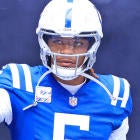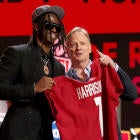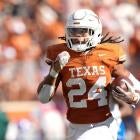Every NFL season is a small sample, and every offseason features significant turnover. While we often discuss how coaching and personnel changes might impact future results, it can be difficult to appropriately weight how past outcomes were impacted by variance.
Ex Post Outcome is a series dedicated to analyzing 2018 results through this lens to provide actionable intel for how to exploit recency bias in 2019 drafts.
Former fifth overall pick Corey Davis enters his third season in 2019 with more target competition than ever. The Titans get Delanie Walker back healthy, added Adam Humphries in free agency, and drafted Ole Miss standout A.J. Brown in the second round. That helps explain why Davis, the PPR WR27 in 2018, is going off the board at WR33 on average in early best-ball drafts.
Is that a fair price for Davis as he enters his third NFL season? Or an overreaction to the perceived disappointment of his Year 2 finish after he was selected as the WR25 on average last year?
Reviewing 2018
The biggest knock on Davis in 2018 was inconsistency. Indeed, while he hit double-digit targets four times, he had seven or fewer in each of the other 12 games. He caught three or fewer passes in half of his games.
Team context played a huge role, though. Marcus Mariota suffered an elbow injury to his throwing arm in Week 1, and the Titans subsequently threw 25 or fewer passes in eight games. The rest of the league's teams averaged 2.4 of these low-volume games.
Among those games were five of Davis' eight games with three or fewer catches, including his low point, a one-catch game in a Week 6 shutout loss to Baltimore during which Tennessee threw just 15 passes, fewest by any team in a game last season. In the four games Tennessee threw 30 or more times, Davis had three performances of 12-plus PPR points.
All told, the 2018 Titans threw the second fewest passes of any NFL team in the past five seasons. After totals of 551, 504, and 496 in Mariota's first three NFL seasons, none of which constituted pass-heavy teams, the Titans bottomed out with just 437 pass attempts in 2018.
Did Mariota's injury situation really play a role? His average throw depth certainly seems to indicate he wasn't right. Per FantasyADHD.com, Mariota averaged just 7.6 yards of depth in 2018, a career low, and well off his previous three seasons of 9.2, 9.6, and 8.9.
Naturally, Davis' aDOT also fell, from an 11.8 mark in his rookie season to 10.3 in 2018. While the targets -- and specifically downfield targets -- were fewer and farther between in the Titans' offense, Davis was still a legitimate No. 1, posting a top 10 wide receiver target share of 26%.
Another way to consider the effect of team volume on Davis: Fellow second-year wideout JuJu Smith-Schuster, whose 166 targets last year dwarfed Davis' 112, saw 25% of the Steelers' league-leading 689 pass attempts, a smaller share than Davis.
In terms of efficiency, Davis was solid. His 891 receiving yards put him at an above average 8.0 yards per target. Another stat, RACR (Receiver Air Conversion Ratio, created by FiveThirtyEight's Josh Hermsmeyer), calculates receiving yards per air yard; in other words, a similar measure of efficiency to YPT or YPR, but one that looks at cumulative target depth. In the below graph, the orange line indicates the league average RACR at various depths, while the green line is Davis.

Nearly all receivers post higher RACRs at lower depths, because shorter passes mean fewer air yards and more yards after the catch. Contrary to this, Davis struggled a bit in the short area last season -- which isn't great -- but he proved a capable downfield receiver, with a solidly above average RACR at depths beyond 10 yards (and an above average depth-adjusted RACR overall). Thus, his overall stats were certainly impacted by Mariota's decline in average throw depth.
Davis did struggle to score, posting just four touchdowns to tie him for the fewest of any top-35 PPR receiver last year. A notoriously fickle stat, his 3.6% touchdown rate was well below average even accounting for the underwhelming volume. Of course, Tennessee threw just 16 touchdown passes, fourth-fewest in the league.
Outcome verdict: 25th percentile
It's impossible to detach Davis's disappointing 2018 from Tennessee's team volume, and Mariota's injury and subsequent decrease in average throw depth both impacted Davis heavily. Davis might also be due for some positive touchdown regression going forward.
How to play it
There's little to indicate the Titans will suddenly be pass-happy in 2019, so Davis isn't a screaming buy. But they will almost certainly throw more, and the size of that pass-attempt increase will ultimately determine whether Davis can gain targets even if he loses some of his share to the new faces in the offense.
In my projections, I conservatively kept Tennessee below 500 pass attempts -- just four teams other than Tennessee were below 500 last year -- and dropped Davis' target share to 24%, which still created an increase of six targets from last year. With a slightly improved but still below average touchdown rate attached to that (4.3%), he came out as my WR28 in PPR.
But I believe there is quite a bit more room for him to beat that projection than to fall short of it. If you double the size of the team passing increase I gave the Titans, the output would still be fewer attempts than last year's league average team. If a healthy Mariota means more downfield passing, Davis might not lose anything from his 26% share last year.
And what if Davis takes a step forward? We're still talking about a player who posted four stellar college seasons then commanded 20% of the targets in the games he played as a rookie and backed that up with a 26% target share in year two. His raw numbers have left something to be desired, but we're still talking about a player who has the potential to command an upper echelon target share, regardless of competition. An efficiency step forward could also make my projected yardage and touchdown rates look silly.
Davis would probably be a draft target if he was going WR28, right where I projected him. But he's going outside the top 30 wide receivers, meaning a worthwhile depth receiver whose offense might hold him back a little bit, but who has more upside than 2018 would suggest.
So which Fantasy Football sleepers should you snatch in your draft? And which RB2 can you wait on until late? Visit SportsLine now to get Fantasy Football cheat sheets from the model that called Andrew Luck's huge season, and find out.



























